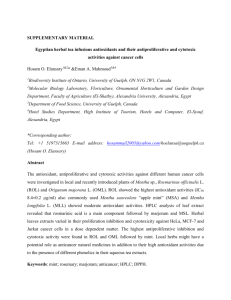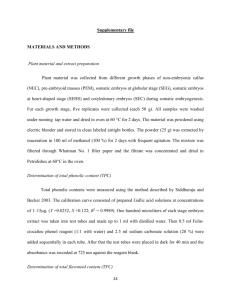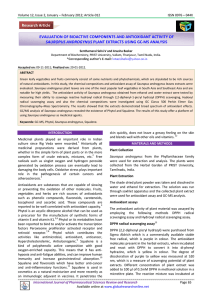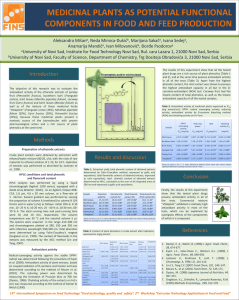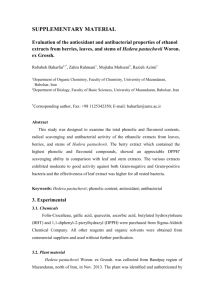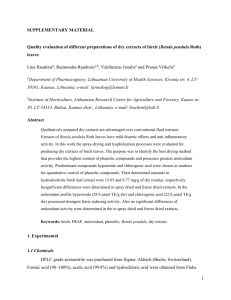Current Research Journal of Biological Sciences 3(4): 351-356, 2011 ISSN: 2041-0778
advertisement
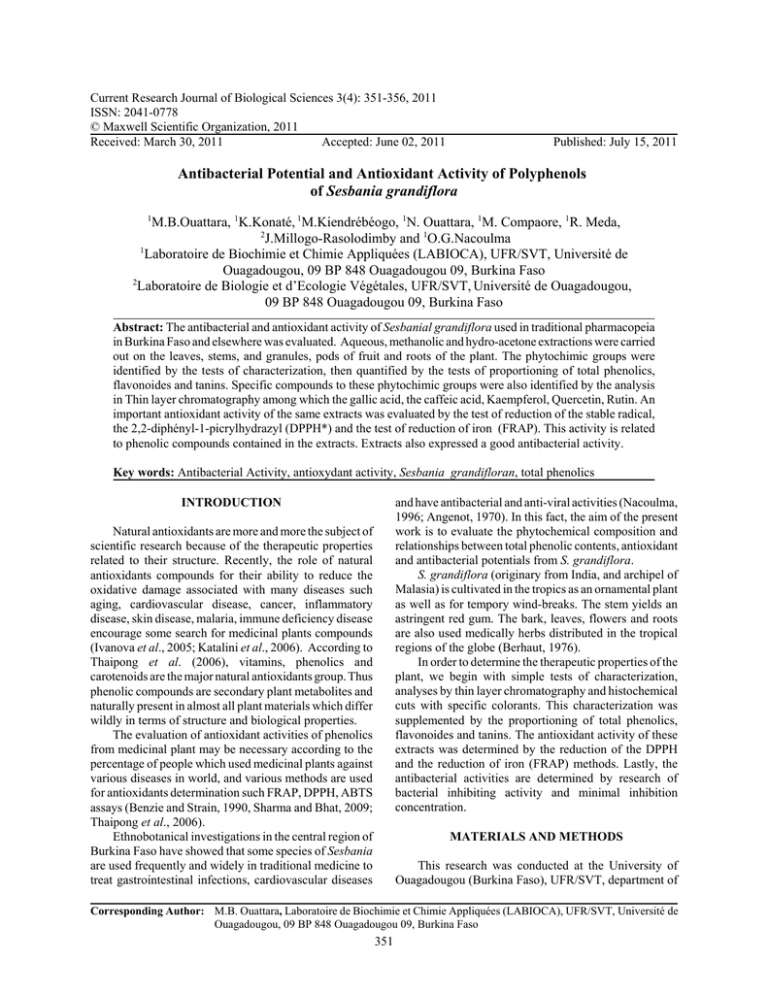
Current Research Journal of Biological Sciences 3(4): 351-356, 2011 ISSN: 2041-0778 © Maxwell Scientific Organization, 2011 Received: March 30, 2011 Accepted: June 02, 2011 Published: July 15, 2011 Antibacterial Potential and Antioxidant Activity of Polyphenols of Sesbania grandiflora 1 M.B.Ouattara, 1K.Konaté, 1M.Kiendrébéogo, 1N. Ouattara, 1M. Compaore, 1R. Meda, 2 J.Millogo-Rasolodimby and 1O.G.Nacoulma 1 Laboratoire de Biochimie et Chimie Appliquées (LABIOCA), UFR/SVT, Université de Ouagadougou, 09 BP 848 Ouagadougou 09, Burkina Faso 2 Laboratoire de Biologie et d’Ecologie Végétales, UFR/SVT, Université de Ouagadougou, 09 BP 848 Ouagadougou 09, Burkina Faso Abstract: The antibacterial and antioxidant activity of Sesbanial grandiflora used in traditional pharmacopeia in Burkina Faso and elsewhere was evaluated. Aqueous, methanolic and hydro-acetone extractions were carried out on the leaves, stems, and granules, pods of fruit and roots of the plant. The phytochimic groups were identified by the tests of characterization, then quantified by the tests of proportioning of total phenolics, flavonoides and tanins. Specific compounds to these phytochimic groups were also identified by the analysis in Thin layer chromatography among which the gallic acid, the caffeic acid, Kaempferol, Quercetin, Rutin. An important antioxidant activity of the same extracts was evaluated by the test of reduction of the stable radical, the 2,2-diphényl-1-picrylhydrazyl (DPPH*) and the test of reduction of iron (FRAP). This activity is related to phenolic compounds contained in the extracts. Extracts also expressed a good antibacterial activity. Key words: Antibacterial Activity, antioxydant activity, Sesbania grandifloran, total phenolics and have antibacterial and anti-viral activities (Nacoulma, 1996; Angenot, 1970). In this fact, the aim of the present work is to evaluate the phytochemical composition and relationships between total phenolic contents, antioxidant and antibacterial potentials from S. grandiflora. S. grandiflora (originary from India, and archipel of Malasia) is cultivated in the tropics as an ornamental plant as well as for tempory wind-breaks. The stem yields an astringent red gum. The bark, leaves, flowers and roots are also used medically herbs distributed in the tropical regions of the globe (Berhaut, 1976). In order to determine the therapeutic properties of the plant, we begin with simple tests of characterization, analyses by thin layer chromatography and histochemical cuts with specific colorants. This characterization was supplemented by the proportioning of total phenolics, flavonoides and tanins. The antioxidant activity of these extracts was determined by the reduction of the DPPH and the reduction of iron (FRAP) methods. Lastly, the antibacterial activities are determined by research of bacterial inhibiting activity and minimal inhibition concentration. INTRODUCTION Natural antioxidants are more and more the subject of scientific research because of the therapeutic properties related to their structure. Recently, the role of natural antioxidants compounds for their ability to reduce the oxidative damage associated with many diseases such aging, cardiovascular disease, cancer, inflammatory disease, skin disease, malaria, immune deficiency disease encourage some search for medicinal plants compounds (Ivanova et al., 2005; Katalini et al., 2006). According to Thaipong et al. (2006), vitamins, phenolics and carotenoids are the major natural antioxidants group. Thus phenolic compounds are secondary plant metabolites and naturally present in almost all plant materials which differ wildly in terms of structure and biological properties. The evaluation of antioxidant activities of phenolics from medicinal plant may be necessary according to the percentage of people which used medicinal plants against various diseases in world, and various methods are used for antioxidants determination such FRAP, DPPH, ABTS assays (Benzie and Strain, 1990, Sharma and Bhat, 2009; Thaipong et al., 2006). Ethnobotanical investigations in the central region of Burkina Faso have showed that some species of Sesbania are used frequently and widely in traditional medicine to treat gastrointestinal infections, cardiovascular diseases MATERIALS AND METHODS This research was conducted at the University of Ouagadougou (Burkina Faso), UFR/SVT, department of Corresponding Author: M.B. Ouattara, Laboratoire de Biochimie et Chimie Appliquées (LABIOCA), UFR/SVT, Université de Ouagadougou, 09 BP 848 Ouagadougou 09, Burkina Faso 351 Curr. Res. J. Biol. Sci., 3(4): 351-356, 2011 Biochemistry-Microbiology, in the Laboratory of Applied Chemistry and Biochemistry, specializes in medicinal plants. The samples were collected during the months from September to October 2007. The studies were conducted from November 2007 to December 2010. alkaloids, test of FeCl3 for the tanins and total phenolics, test of Shibata for the flavonoides, test of LibermannBuchard for the steroids and triterpenes, reaction to the NH4OH followed by an observation with UV 254 nm for coumarins. Biological materials: Leaves, stems, granulates, pods and roots of Sesbania grandiflora (noted E3 in the study) were collected in the site of University of Ouagadougou (Burkina Faso). The vegetable specie was identified by the botanists of the University of Ouagadougou. Parts of plants were dried during ten days at the laboratory at a temperature of surroundings 30ºC, safe from the light, pulverized and preserved in plastic sachets safe from the light. Determination of total phenolics by the Method of Singleton (1999): A volume of 100 :L of extract is mixed with 500 :L of the reagent of Folin-Ciocalteu (0.2 N) in methanol. After 5mn of incubation, add 400 :L of an aqueous sodium carbonate solution (75 g/L). The white consists of 100 :L of water, 500 :L of reagent of Folin-Ciocalteu (0.2 N) and 400 :L of aqueous sodium carbonate 75 g/L. The gallic acid is used as standard for the establishment of the curve of reference. Let colouring develop two hours during, and read the absorbance with 760nm. Aqueous extraction: 25g of vegetable powder is put in a balloon containing 250 mL of distilled water. Fix the balloon at the Soxhlet and to connect the device by regulating the temperature with 100ºC. At the end of 30 mn after boiling, stop the extraction. Filter and freeze the filtrate at least 24 h then lyophilize and preserve safe from moisture. Thin layer chromatography: Thin layer chromatography for phenolic acid and flavonoid was realized by Wagner and Bladts (1996) and Medié-Sarié et al. (2004) method by using plates (selica gel 60F254, KIESEL GEL, 10 cm x 10 cm) which spotted by standards and samples. The system of migration used for the migration is polar. Ice Ethyl acetate/Formic acid/Acetic acid/Water (V/V/V/V: 7/1,1/1,1/2). Methanolic extraction: With the cartridges of extraction, pour 25 g of powder vegetable. In a balloon of extraction pour 300 mL of methanol. (Add three stones pounces). Make the extraction in the device of solid-liquid extraction uninterrupted of Soxhlet type, until exhaustion. The process lasts surroundings four hours (the liquid of the Soxhlet becomes clear). At the end of the extraction, and after a cooling, take the extract and concentrate it in the device of Rotavapor. When the near total of methanol is recovered, the edge of the balloon containing the extract becomes black. Stop the concentration; recover the extract in Petri plate (weigh the Petri plate before pouring the concentrated extract). Leave with the free air during some days until methanol evaporates completely. The extract becomes dry. Weigh again each Petri plate to evaluate the quantity of extract obtained. Recover the extracts and preserve them in well closed bottles. Evaluate the output and continue the tests. Antioxidant activity by the reduction of the DPPH: Determination of the antioxidant activity of the extracts can be undertaken in vitro by their capacity to trap radicals. Thus, ORAC method (Radical Oxygen Capacity Absorbance (Antolovich et al., 2002), the TRAP method (Total Trapping Radical) (Ricardo da Salva et al., 1991), are used for the trapping of peroxides ROO*. Ferric ions trapped by the method of FRAP (Ferric ion Antioxidant Reducing Parameter) (Benzie and Strain, 1990), radicals ABTS* by method ABTS (2,2 Azinobis - 3 - ethyl Benzothyazoline - 6 - sulphonate) (Re et al., 1999) and free radical DPPH* by method DPPH (2,2 Di-Phényl-1Pycril Hydrazil) (Sharma and Bhat, 2009). It is often necessary to combine the methods to have a precise antioxidant capacity of an extract, counts held of the complexity of the oxidation and the diversified nature of antioxidants. However, for the compounds rich in phenols, it is recommended to use the method of reduction of the free radical DPPH* on the following mechanism: Hydro-acetone extraction: Weigh 25 g of powder vegetable and pour 250 mL of aqueous acetone (80% acetone and 20% distilled water). Close and let it for agitation during 72 h and filter the extract. The filtrate is concentrated in the device of Rotavapor. Acetone is recovered then evaporated water. Recover the extract in Petri plate (Weigh the Petri plates before pouring the concentrated extract). Let it dry in a drying oven and weigh the dry extract again in order to evaluate the output. 6 DPPHH + Phe-O*, DPPH* + Phe-OH the following reactions result from this first: 6 Phe - O - O-Phe Phe-O* + Phe-O* Phe-O* + DPPH* 6 Phe - O - DPPH DPPH* + Phe-OH 6 DPPHH + Phe-O- Tests of characterization: The extracts carried out were subjected to the following tests according to the procedure described by Ciulei (1982): Test of Dragendorf for Radical DPPH* does not form dimer and remains in monomeric form at ambient temperature. 352 Curr. Res. J. Biol. Sci., 3(4): 351-356, 2011 Table 1: Tests of characterization of aqueous and methanolic extracts of Sesbania grandiflora Alkaloides Coumarins Flavonoides Saponosids Terpens and stéroid Aqueous extract of S. grandiflora Leaves 30 Traces + + + Stems 31 Traces + + + Granulates 32 Traces + + + Pods 33 Traces + + + Roots 34 traces + + Méthanolic extract of S. grandiflora Leaves 35 Traces + + + Stems 36 Traces + + + Granulates 37 Traces + + + Pods 38 Traces + + + Roots 39 traces + + + Tanins et Polyphenols + + + + + + + + + positive bacteria. We test another strain of S. aureus (sauvage) and a strain of Vibrio cholerae (sauvage) In a simplified way, when a solution of DPPH is in the presence of a reducing substance (an antioxidant, noted AH), the reaction gives place to the reduced form of the DPPH with loss of the color violet (with a yellow color residual blade of the grouping picryl). The reaction can be written: Research of the bacterial inhibiting activity: Preparation of inoculate: The inoculate of bacterial strains were adjusted to 0.5 Mc Farland stard turbidity (106 colony forming units (cfu) per millilitre (Ezoubeiri and al. 2005). In each Petri plate containing solid medium, put 3mL of the suspension, 106 colony forming units (cfu) per millilitre (Ezoubeiri and Al, 2005). Eliminate excess from inoculate. Incubate 24 h. Make wells and put it 50 :L of the extracts (50, 100, 200, 500 :g/mL) or antibiotics of reference. Incubate during 24 h. Measure the diameters of inhibition. Each test is carried out three times. DPPH* + AH 6 DPPH-H + A* For the test, prepare the solution of 2 mg of DPPH dissolved in one liter of methanol. The extracts are diluted in methanol by the technique of limiting dilution. In a Ependorf tube, put 250 :L of extract diluted in methanol and 500 :L of the solution of DPPH (2 mg/L). Quercetin is used as reference. The white consists of 250 :L of methanol and 500 :L of DPPH (2 mg/L). The Zero consists of methanol 750 mL. The absorbance is read all the 15 mn with 517 nm. Minimal inhibition concentration (MIC): Micro-well dilution assay: Minimum Inhibition Concentration (MIC) was determined by the microdilution method in culture broth as recommended by Eloff (1999). The 96-well micro-plate (NUNC, Danemark) containing 100:L of Mueller Hinton (MH) broth were used. For each bacteria strain, three columns of eight wells to the microplate were used. Each well has getting: the culture medium + extract + inoculums (10 :L of inoculate) and INT (50 :L; 0.2 mg/mL). The plate were covered and incubated overnight at 37ºC and at 44ºC for Escherichia coli for 24 h. Each MIC experiment was repeated three times. Inhibition of bacterial growth was judged by rose or yellow colour. The MIC is defined as a lowest concentration of the extract at which the bacteria does not demonstrate the visible growth. Antioxidant activity by FRAP method: In test tubes, mix 0.5 mL of extract with 1,25 mL phosphates buffer (0.2M, pH = 6.6) and 1.25 mL of K3Fe (CN)6. Incubate the tubes at 50ºC during 30 mn. Add 1.25 mL TCA 10% and to centrifuge 10 mn with 2000 rpm. In Ependorf tubes, to introduce 0,625 mL of extract above obtained and centrifuged, 0.625 mL H2O and 0.125 mL of FeCl3. The reading is made with 700 nm, against a curve of reference of ascorbic acid. Antibacterial activity: Extracts of Sesbania grandiflora are tested on the bacteria. The antibiotics of reference are Penicillin and Ampicillin. Bacterial strains: Some strains of bacteria from the American Type Culture Collection (ATCC, Rockville) were tested: Escherichia coli ATCC 25922, Bacillus cereus ATCC 13061, Proteus mirabilis ATCC 35659, Salmonella typhimirium ATCC 13311 and Staphylococcus aureus ATCC 6538. Among the strains bacteria, Escherichia coli, Proteus mirabilis and Salmonella typhimirium are Gram-negative bacteria; Bacillus cereus and Staphylococcus aureus are Gram- RESULTS AND DISCUSSION Preliminary phytochimic siftings: Table 1 summarizes results of the phytochimic sifting. The tanins, flavonoides, coumarins, steroids and triterpens were present on all organ tested, with more or less important contents according to the intensity of colouring obtained. The alkaloids are generally found in the form of traces. The saponosides were more often present in methanolic 353 Curr. Res. J. Biol. Sci., 3(4): 351-356, 2011 extracts than aqueous extract. The saponosides would be rather present in the form of triterpens and steroids that in the form of heterosides. 60 Phenolic compounds Tanins Flavonoides Mg/g dry extract 50 The analysis on thin layer: The system of Icy acetic Acid /ethyl acetate /Acid formic /Water (V/V/VV: 7/1,1/1,1/2) showed that the same chemical groups are found in the various parts of the plant, but often with different contents, according to the thickness of the band observed. Inside the chemical groups highlighted by the tests of simple characterization, the compounds of reference used made it possible to identify among the flavonoides, mainly Quercetin and Kaempferol, Rutin and among the tanins, the caffeic and gallic acids. These compounds are abundant in the extracts of leaves and stems. 40 30 20 10 0 Fig. 1: Leaves Stems Granules Pod Total phenolics, Tanins, Flavonoides of methanolic extracts of Sesbania grandiflora Table 2 : Reduction Percentage of DPPH Extract Concentration DO mg/mL 517 nm E3-Le-Met-OH 8,00 0,29 16,00 0,20 31,25 0,11 62,50 0,06 125,00 0,01 E3-St-Met-OH 8,00 0,33 16,00 0,23 31,25 0,14 62,50 0,09 125,00 0,02 E3-Gr-Met-OH 8,00 0,36 16,00 0,26 31,25 0,16 62,50 0,10 125,00 0,04 E3-Po-Met-OH 8,00 0,36 16,00 0,27 31,25 0,22 62,50 0,18 125,00 0,14 E3-Ro-Met-OH 8,00 0,36 16,00 0,28 31,25 0,24 62,50 0,17 125,00 0,12 Total Phenolics, flavonoides and tannins: Figure 1 indicates the measurement of these compounds. The total phenolics of the extracts were given thanks to the curve of reference of the gallic acid, whose equation of the righthand side is y = 0.006x + 0.055 with the coefficient of correlation R2 = 0.992. The phenolic compounds are more abundant in the leaves and the stems that in the other parts of the plant. Phenolic totals of the aqueous extracts, methanolic and hydro-acetone: The proportioning of the total phenolics of the three types of extracts, shows, as Fig. 2 indicates it, that the hydro-acetone extract gives a better rate than the methanolic extract then the aqueous extract. The phenolic compounds remain high all the same in the extracts methanolic and sometimes close to those of the hydroacetone extracts. Antioxidant activity by method DPPH: The capacity of the extracts to reduce the DPPH was tested. The reduction of the DPPH by the extracts makes decrease colouring initial violet. Two parameters were given for each extract: percentage of reduction (Pr) of the DPPH, concentration in extracts involving 50% of reduction (EC50). Root Pr % 19,44 44,44 69,44 83,33 97,22 8,33 36,11 61,11 75,00 94,44 0,00 27,78 55,56 72,22 88,89 0,00 25,00 38,89 50,00 61,11 0,00 22,22 33,33 52,78 66,67 Table 3: EC50 of methanolic extracts of S. grandiflora (E3) Extract EC50 mg/mL E3-Fe-Met-OH 40,32 E3-Ti-Met-OH 24,91 E3-Gr-Met-OH 393,90 E3-Go-Met-OH 6903,00 E3-Ra-Met-OH 1049,98 Percentage of reduction (Pr): Results are consigned in Table 2. This parameter was evaluated by the equation: from the stem and the leaves of Sesbania grandiflora presented a good anti oxidant activity: 40 and 24 :g/mL, compared to the Quercetin has whose EC50 was 3.6 :g/mL. The antioxidant activity of these extracts could be allotted to certain compounds identified into CCM (the caffeic acid, gallic acid, quercetin, rutin) (Gülçin, 2006, Katalini, 2006, Medié-Sarié et al., 2004). Pr = [(Absorbance of controls) - (Absorbance of antioxidant)/(Absorbance of controls)] × 100 Determination of the EC50: Table 3 gives the value of the EC50. The antioxidant concentration necessary to reduce 50% of the initial concentration of DPPH, EC50, is graphically given by the curve Ln (Pr) = f(concentration extracted). When the percentage of reduction is high, the concentration necessary of this extract to obtain 50% of reduction of the DPPH is less. This extract acts with low dose to reduce the DPPH. Breadths extracted methanolic Antioxidant activity by FRAP method: Figure 3 indicates the values of the Antioxidant activity of the extracts. The measurement of the Antioxidant activity of 354 Curr. Res. J. Biol. Sci., 3(4): 351-356, 2011 Concentration mg Gallic acid/g dry extract Aqueous Methanolic 60 Acetonic 53.48 50 41.35 37.54 40 31.67 29.29 30 20 10 0 Leaves Pod Granules Stems Root Fig. 2: Total phenolics of aqueous, methanolic and acetonic extracts of Sesbania grandiflora Table 4: bacterial inhibiting activity Staphylococcus Extracts Nº aureus Gram + E3-Fe35 30 mm E3-Ti36 32 mm E3-Gr37 28 mm E3- Go38 14 mm E3-Ra38 26 mm Penicillin 22 mm Ampicillin 22 mm Staphylococcus aureus (sauvage) Gram + 29 mm 36 mm 34 mm 14 mm 24 mm - Bacillus cereus Gram + 30 mm 30 mm 24 mm 12 mm 22 mm 20 mm 26 mm Salmonella typhymirium Gram + 30 mm 40 mm 24 mm 32 mm 35 mm - Vibrio cholerae Gram 25 mm 26 mm 22 mm 12 mm 20 mm 20 mm - Escherichia coli Gram 32 mm 32 mm 30 mm 32 mm 38 mm - S. aureus (sauvage) 12.5 12.5 12.5 50.0 12.5 - B. cereus 12.5 12.5 12.5 50.0 12.5 2 2 S. thyphimirium 12.5 12.5 12.5 25.0 12.5 2 - V. cholerae 12.5 12.5 12.5 50.0 12.5 2 2 E. coli 12.5 12.5 12.5 25.0 12.5 2 2 Proteus mirabilis Gram 24 mm 28 mm 32 mm 12 mm 22 mm 30 mm Table 5: Minimal inhibition concentration Extract E3-FeE3-TiE3-GrE3- GoE3-RaPenicillin Ampicillin Nº 35 36 37 38 39 S. aureus 12.5 12.5 12.5 50.0 12.5 2 2 the ferric ions by the extracts methanolic of Sesbania grandiflora was evaluated in ascorbic equivalent of Acid used to establish a curve of reference. Equivalent Ascorbic acid µg/ml 1.60 Qualitative antioxidant activity test of polyphenols, tanins and flavonoides: The qualitative antioxidant activity was tested by pulverization of the bands observed into CCM by a methanolic solution of DPPH (2mg/mL of colouring violet). The antioxidant potential of these compounds was expressed by the positive reaction with the solution of DPPH. These results are in agreement with several studies which showed the antioxidant activity of polyphenols, in particular those of Meda et al. (2005). E3_Met-OH P. mirabilis 12.5 12.5 12.5 50.0 12.5 2 2 1.38 1.40 1.20 1.00 0.80 0.75 0.69 0.58 0.60 0.47 0.40 0.20 0.00 Leaves Stems Granules Pod Root Fig. 3: Antioxidant actitivty of methanolic extract with FRAP method Antibacterial activity: Tables 4 and 5, respectively indicate the results of determination of the bacterial inhibiting activity and the inhibiting minimal concentration of the extracts. All the extracts were active on all the strains of bacteria, with diameters of inhibition most important, compared to antibiotics of reference, for which strains were sensitive. Certain extracts were active on strains resistant to Penicillin. Indeed, the extracts inhibited the growth of S. aureus (sauvage), Salmonella 355 Curr. Res. J. Biol. Sci., 3(4): 351-356, 2011 typhymirium, E. coli, P. mirabilis, resistant to penicillin, the extracts were active. Also on S. aureus (sauvage), Salmonella typhymirium, V. cholerae, E. coli, P. mirabilis, resistant to Ampicillin, the extracts were active. The inhibiting minimal concentrations of the bacteria by the extracts indicate that the extracts generally act with low dose: surroundings 12.5 mg/mL of extract, even if these concentrations remain high compared to penicillin or with ampicillin, 2 mg/mL. The extracts contain several chemical compounds while the antibiotics of reference are purified, containing only the inhibiting molecules. Gülçin, I., 2006. Antioxidant activity of caffeic acid (3,4dihydroxycinnamic acid). Toxicology, 217: 213-220. Ivanova, D., D. Gerova, T. Chervenkov and T. Yankova, 2005. Polyphenols and antioxidant capacity of Bulgarian medicinal plants. J. Ethnopharm., 96: 145-150. Katalini, V., M. Milos, T. Kulisic and M. Jukic, 2006. Screening of 70 medicinal plant extracts for antioxidant capacity and phenols. Food Chem., 94: 550-557. Medié-Sarié, M., J. Ivona, A. Smolcié-Bubalo and M. Ana, 2004. Optimization of chromatographic conditions in Thin Layer chromatography of flavonoids and phenolic Acids. Croatica Chem. Acta., 77(1-2): 361-366. Meda, A., C.E. Lamien, M. Romito, J. Millogo and O.G. Nacoulma, 2005. Determination of the total phenolic, flavonoid and proline contents in Burkina Fasan honey, as well as their radical scavenging activity. Food Chem., 91: 571-577. Nacoulma, O.G., 1996. Medicinal plants and traditional medicinal practices in Burkina Faso: The case of the central plateau T1 & T2.Thèse Doct. ès Sciences Nat. University of Ouagadougou, pp: 242, 285. Re, R., N. Pellegrini, A. Proteggente, A. Pannala, M. Yang, C. Rice-Evans, 1999. Antioxydant activity applying an improved ABTS radical cation decolorization assay. Free Rad. Biol. Med., 26: 12311237. Ricardo da Salva, J.M., N. Darmon, Y. Fernandez and S. Mitjavila, 1991. Oxygen free radical scavenger capacity in aqueous models of different procyanidins from grape seeds. J. Agric. Food Chem., 39: 1549-552. Sharma, O.P. and T.K. Bhat, 2009. DPPH antioxidant assay revisited. Food Chem., 113(4): 1202. Singleton, V.L., R. Orthofer and R.M. Lamuela-Raventos, 1999. Analysis of total phenols and other oxidation substrates and antioxidants by means of FolinCiocalteu reagent. Methods Enzymol., 299: 152-178. Thaipong, K., U. Boonprakob, K. Crosby, L. CisnerosZevallos and H.D. Byrne, 2006. Comparison of ABTS, DPPH, FRAP, and ORAC assays for estimating antioxidant activity from guava fruit extracts. J. Food Compos. Anal., 19: 669-675. Wagner, H. and S. Bladts, 1996. Plant Drug Analysis: A Thin Layer Chromatography, Atlas. 2nd Edn., pp: 384, ISBN: 0-207-14383-8. CONCLUSION Our results indicate that the extracts of all the parts of the plant of Sesbania grandiflora contain polyphenols having interesting anti oxidant activities, compared to the Ascorbic acid and Quercetin used as reference. These extracts were also able to inhibit the bacterial growth. The spectrum of action of the extracts is broad because it covers the Gram negative and positive bacteria and also some bacteria which are resistant to two antibiotics of reference tested. These results could justify the use of this plant in traditional pharmacopeia. ACKNOWLEDGMENT Authors are grateful to the University Ouagadougou for providing the facilities. of REFERENCES Angenot, L., 1970. Medicinal plants and herbal medicine, Tome, 4(4): 263-278 (In French). Antolovich, M., P.D. Prenzler, E. Patsalides, S. McDonald and K. Robards, 2002. Methods for testing antioxydant activity. Analyst, 127: 183-198. Benzie, I.F. and J. Strain, 1990. The Ferric Reducing Ability of Plasma (FRAP) as a measure of antioxidant power: The FRAP assay. Anal. Biochem., 239: 70-76. Berhaut, J., 1976. Flore illustrated of Senegal. Tome V Government of Senegal, pp: 505-520 Ciulei, I., 1982. Practical manuals on the industrial utilization of chemical and aromatic plants. Methodology for analysis of vegetable drugs Ed. ministry of chemical industry. BUCHAREST, pp: 67. Eloff, J.N., 1999. The antibacterial activity of 27 southern african members of the Combretaceae. S. Afr. J. Sci., 95: 148-152. Ezoubeiri, A., C.A. Gadhi, N. Fdil, A. Benharref, M. Jana and M. Vanhaelen, 2005. Isolation and antimicrobial activity of two phenolic compounds from Pulicaria odora L. J. Ethnopharm., 99: 287-292. 356

